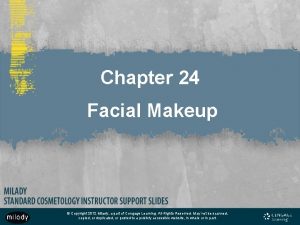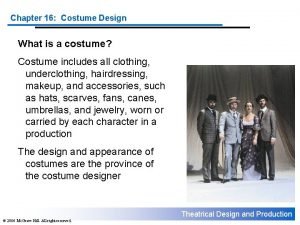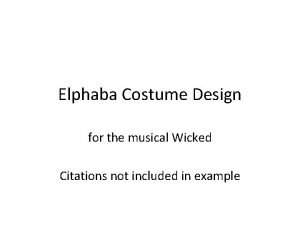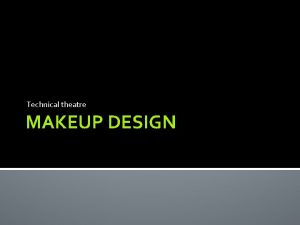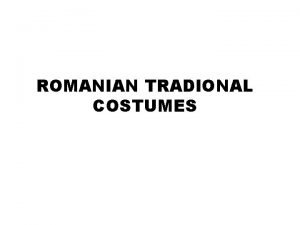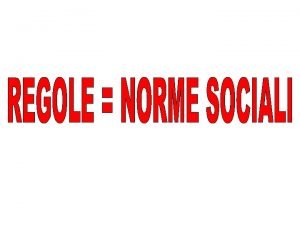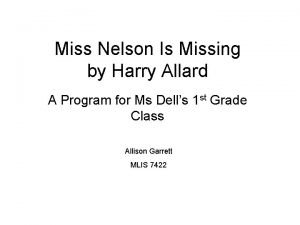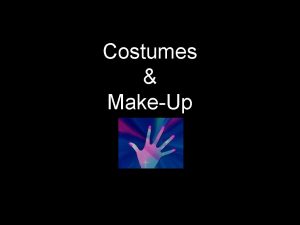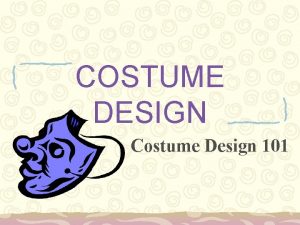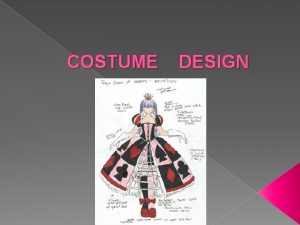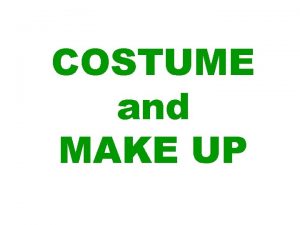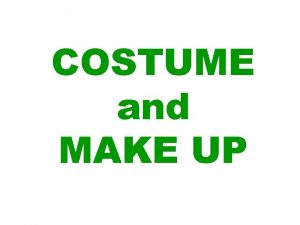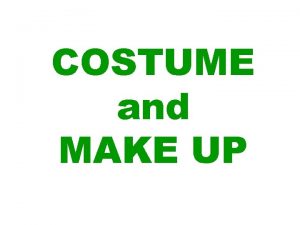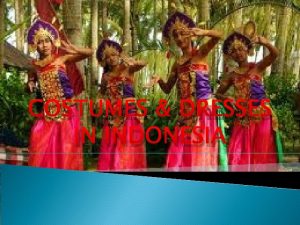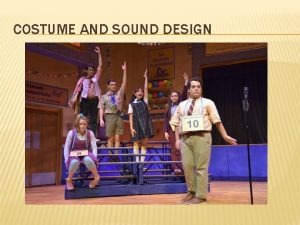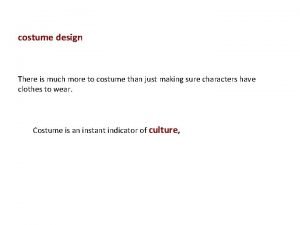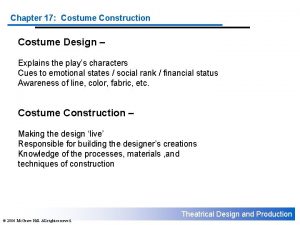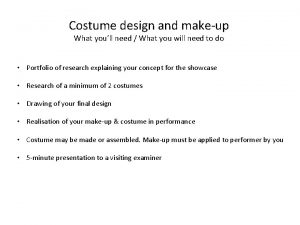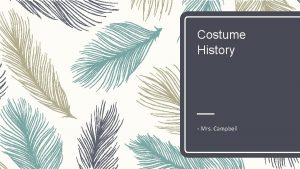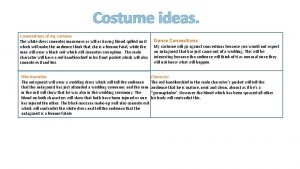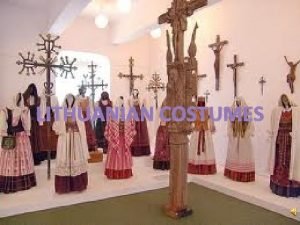Costumes MakeUp Costume Design Team Designing appropriate costumes




















- Slides: 20

Costumes & Make-Up

Costume Design Team • Designing appropriate costumes for actors and actresses to present themselves on the stage • Ordering and creating the costumes on time for production • Maintaining the costumes in top condition • Fixing or repairing any damages to costumes that may occur. • Applying make-up to the actors or actresses • Supporting the actors and actresses in fitting into their costumes or switching to other costumes

Analyzing Costumes • These are things to look at when we are looking at costumes to help the characters express themselves: • Color • Weight • Length/Height • Props • Gender • Occupation • Culture • Character Emotions • Character’s Story






• Design Sketch • Fabric Swatch • Costume • Color Rendering • Costume Fitting • Props

Costume Terms • Costumes- Clothes actors, actresses, singers, dancers, use on stage to portray their performance on stage. • Props-Extra items for actors or actresses to have on their hands to enhance their presentation. This can be accessories, items, etc. • Design Sketch-Rough Draft of a costume the actor/actresses will play as. These are usually done in drawings. • Costume Fitting-Actors and actresses being measured to fit in their costumes accurately to enhance their performance. • Fabric Swatch-A piece of small clothing used as a sample for people to test the fabric and feel the design. • Color Rendering-Light Source showing true colors as it would show on Outdoors.

Design Sketch

Newspaper Costumes • Create a group of 4 -6 people • Draw a slip containing what costume you will design • Once you know what kind of costume you will make, each student will create a rough draft of what the final costume could look like. (Do the best you can) • Discuss what you will need to make the costume convincing to audience.

Costume Analysis Questions(Part 1) 1. How is the Costume related to the scene being played now? 2. What time of the day is it? 3. Is there conflict or drama in the scene? 4. What Country or Culture is the costume from? 5. Is the Costume related to an occupation (Gym, Workplace)? 6. Does the clothing represent low, middle, or high class?

Costume Analysis Questions Part 2 7. How old is the character wearing the costume? 8. What is the gender of the characters wearing the clothing? 9. What is the size of the clothing? 10. Are there any unique props, tools, or accessories notable on the character? 11. What are the roles of the characters wearing the costumes (Ex: Protagonist, Antagonist, etc. )? 12. What are the materials used to make the costume?

Newspaper Costume Grade • Design Sketch-Create a rough draft of a prop or the costume to contribute to the team. (4 Points) • Three Props-Each propr is related to the costume you are designing (4 Points Each) • Accuracy and Clarity-Does the Costume express what your goal is? Can we tell what the costume is supposed to be (10 Points) • Clean-Up-Did you pick all the scraps and took care of your station to keep it clean? (4 Points as a Group) • Picture-Take a picture of the final product to complete the project. (2 Points) • Team Evaluation-Fill out an evaluation form to reflect on how each member of your participated. (4 Points)

Research and Preparation • Once a type of costume/clothing is determined for the actors and actresses, the costume designer must do the following: 1. Analyze Budget-How much money is available to purchase the needed materials and what the cost will be for the resources needed 2. Talk with the Script Writer-When the costumes will be needed and when will the actor/actresses will need to change 3. Set Deadlines-Find out when the costumes need to be done by and how long it will take for the costumes to be finished 4. Rough Draft-Design a rough draft sketch. Usually 3 -5 different sketches are made and shared with the Director to receive input. 5. Final Draft-After collaboration with the director, scenic designer, and script writer, a final draft will be created for the costume design.

Analyze the Following Costumes



 Image enhancers milady
Image enhancers milady Zazu puppet
Zazu puppet What is a costume
What is a costume Wicked the musical costumes
Wicked the musical costumes Theatre makeup design
Theatre makeup design Going native project management
Going native project management Team spirit becomes team infatuation
Team spirit becomes team infatuation The white team cheers for the blue team, just like
The white team cheers for the blue team, just like Use of monoglyph class in lexi document is -
Use of monoglyph class in lexi document is - Designing a document editor in design patterns
Designing a document editor in design patterns Hungarian traditional wear
Hungarian traditional wear Pirate costume
Pirate costume What condition threatens peetas life
What condition threatens peetas life Vocabulary hat parade
Vocabulary hat parade Romanian traditional clothing
Romanian traditional clothing Johnny appleseed costume
Johnny appleseed costume Norme morali esempi
Norme morali esempi Miss nelson costume
Miss nelson costume Costume traditionnel bourgogne
Costume traditionnel bourgogne La dépouille du minotaure en costume d'arlequin analyse
La dépouille du minotaure en costume d'arlequin analyse The tailor asl translation
The tailor asl translation
